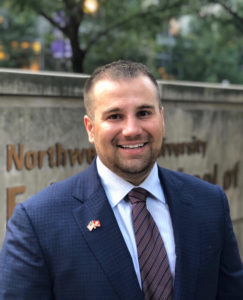
Tuition aid supported by the U.S. Department of Veterans Affairs for military veterans enrolling in medical school covers a smaller proportion of tuition, as compared to aid for other graduate programs, according to a Northwestern Medicine study published in the Journal of the American Medical Association.
This is likely due to medical schools’ unfamiliarity with Veterans Affairs (VA) tuition aid programs, according to lead author Stephen Graves, a fourth-year student in the dual MD/MBA program and 10-year veteran of the United States Marine Corps (USMC).
“There’s room for improvement; medical schools could be using their scholarship dollars much more effectively,” said Graves, a captain in the USMC Reserve who was honorably discharged from active duty in 2013 and from active reserves in 2016.
VA tuition aid for veterans largely comes from the “Post-9/11 GI Bill®,” a scholarship program available to all honorably discharged veterans that can be used for most undergraduate and graduate education.
Supplementing that aid is the “Yellow Ribbon (YR) Program,” an opt-in program that matches an aid contribution from an academic graduate program. For example, if Feinberg offered a scholarship to veterans worth $8,000, the YR program would match that sum.
However, when entering medical school, Graves noticed YR program participation was low when compared to the business and law school programs, at Northwestern and at other schools across the country.
“They all followed the same trends,” Graves said.
This turned into a nationwide statistical analysis, using tuition and aid data from medical, law and business school programs at over 100 schools.
Graves found the costs of attending medical school for veterans was consistently higher than other graduate programs, with an average of just 45 percent of tuition covered by aid — in comparison to an average of 85 percent for JD programs and 100 percent for MBA programs.
Over four years, this shortfall adds up to a median tuition cost of over $110,000 for veterans in MD programs, despite receiving “GI Bill” benefits. In comparison, Graves found most veterans in MBA programs had no out-of-pocket costs.
“We think this is due to MD programs benchmarking their support levels to other MD programs and not looking at other professional degree programs,” Graves said.
This is compounded by the relative lack of veterans in medical school when compared to other graduate programs, according to Graves.
“Other graduate programs are more experienced with providing scholarship support to veterans,” Graves said.
These factors lead to low participation in the YR program, leaving federal aid dollars on the table. Simply shifting scholarships for veterans to the YR program would cover more of their tuition costs, according to Graves.
“While the Post-9/11 GI bill is mandatory, there’s no requirements for participation in the YR program, so it’s not as consistent and contributes to the discrepancies in aid we found,” Graves said. “All professional programs should reexamine their participation levels and determine if they are adequate.”
However, boosting the YR program is not enough: there’s no concrete information about the number of veterans enrolled in or graduating from medical school, complicating research in this area. In the future, Graves hopes to remedy this in a future study, using medical school application, tuition and scholarship data to analyze how aid affects if and where veterans attend medical school.
“Veterans bring a distinct perspective to professions and occupations,” Graves said. “Research has shown 10 percent of the U.S. populace are veterans, and around half receive their care at the VA. With recent shortfalls within the VA healthcare system, all avenues to improve care should be explored, such as increasing the number of veteran physicians in practice and prompting policymakers to consider how healthcare education can enhance care for veterans.”
Other Northwestern Medicine authors include Brandon-Luke L. Seagle, MD, a fellow in gynecologic oncology, Masha Kocherginsky, PhD, associate professor of Preventive Medicine in the Division of Biostatistics and of Obstetrics and Gynecology in the Division of Gynecologic Oncology, Shohreh Shahabi, MD, chief of Gynecologic Oncology and the John and Ruth Brewer Professor of Gynecology and Cancer Research and professor of Medical Social Sciences, and Shahabi lab members Junhua Yang, MS, statistical analyst and Anne Grace, PhD, senior clinical research associate.
The research reported in this publication was supported by grant 4P30CA060553-22 from the National Cancer Institute of the National Institutes of Health.
GI Bill® is a registered trademark of the U.S. Department of Veterans Affairs (VA). More information about education benefits offered by VA is available at the official U.S. government Web site at https://www.benefits.va.gov/gibill.






